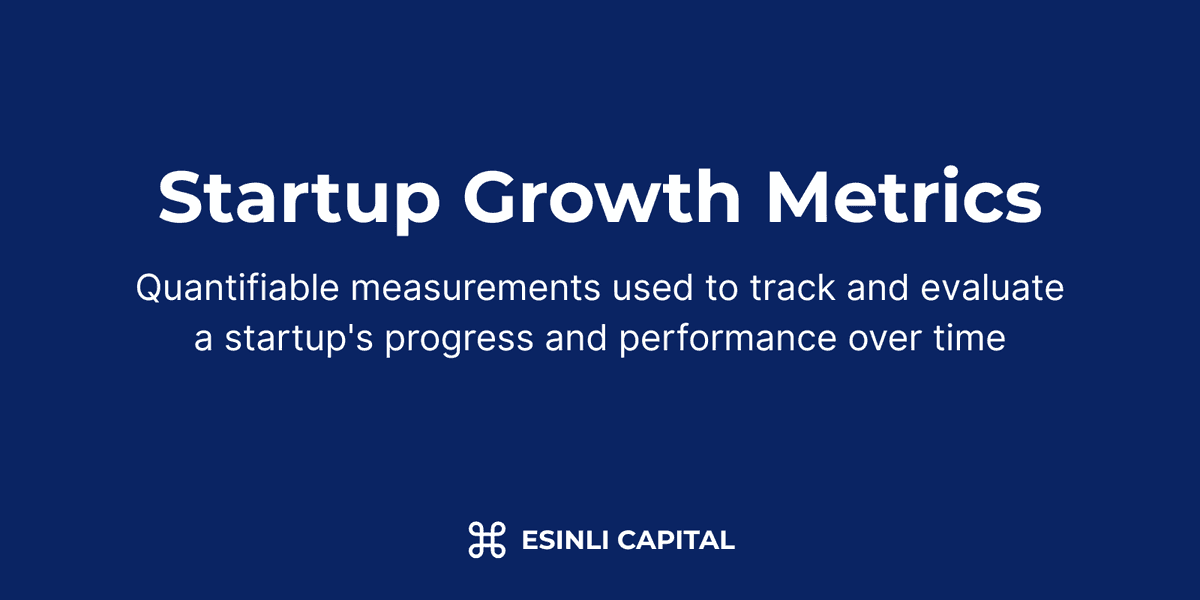In This Article
- What Are Startup Growth Metrics?
- Essential Startup Growth Metrics and Benchmarks
- North Star Metric: Finding Your Primary Growth Indicator
- Cohort Analysis: Tracking Performance Over Time
- Stage-Appropriate Metrics: Measuring What Matters Now
- Growth Accounting: The Mathematical Foundation of Growth
- Essential Startup Growth Metrics and Analysis Methods
- FAQs
- The Bottom Line
- What Are Startup Growth Metrics?
- Essential Startup Growth Metrics and Benchmarks
- North Star Metric: Finding Your Primary Growth Indicator
- Cohort Analysis: Tracking Performance Over Time
- Stage-Appropriate Metrics: Measuring What Matters Now
- Growth Accounting: The Mathematical Foundation of Growth
- Essential Startup Growth Metrics and Analysis Methods
- FAQs
- The Bottom Line

Essential Startup Growth Metrics: KPIs, Benchmarks & Analysis Methods
KEY TAKEAWAYS
- Tracking the right growth metrics helps startups make data-driven decisions, attract investors, and identify opportunities for sustainable growth.
- Core growth metrics include MRR/ARR, CAC, LTV, churn rate, retention rate, and growth rate - with industry-specific benchmarks for each stage.
- Your North Star Metric should align with your value proposition and business model, serving as the single most important indicator of sustainable growth.
- Cohort analysis provides deeper insights than aggregate metrics by tracking how specific user groups behave over time.
- Different growth stages require adjusting your metrics focus - from product-market fit metrics in early stages to efficiency metrics at scale.
What Are Startup Growth Metrics?
Startup growth metrics are quantifiable measurements used to track and evaluate a company's progress and performance over time. Unlike traditional business metrics that might focus primarily on revenue and profit, startup metrics often emphasize user engagement, acquisition efficiency, retention, and indicators of product-market fit. These metrics help founders, investors, and team members understand if the business is on a sustainable growth trajectory.
For startups, tracking the right metrics is critical because resources are limited, and the window for achieving sustainable growth is often narrow. Effective measurement allows you to:
- Make data-driven decisions rather than relying on intuition
- Identify bottlenecks in your growth funnel
- Allocate resources to the highest-impact activities
- Demonstrate traction to potential investors
- Set achievable goals for your team
The metrics you prioritize will evolve as your startup grows. In the earliest stages, you might focus on user engagement and activation. As you scale, efficiency metrics like Customer Acquisition Cost (CAC) and Lifetime Value (LTV) become increasingly important. At maturity, retention and profitability metrics take center stage.
Essential Startup Growth Metrics and Benchmarks
Revenue Metrics
Monthly Recurring Revenue (MRR) is the predictable total revenue generated by your business from all active subscriptions in a month. For SaaS companies and subscription businesses, this is often considered the most important top-line metric.
MRR = Number of customers × Average revenue per user (ARPU)
Annual Recurring Revenue (ARR) is simply MRR multiplied by 12, providing a yearly perspective on your recurring revenue.
ARR = MRR × 12
Revenue Growth Rate measures how quickly your revenue is increasing over a specific time period, typically month-over-month (MoM) or year-over-year (YoY).
Growth Rate = (Current Period Revenue - Previous Period Revenue) / Previous Period Revenue × 100%
Industry Benchmarks: While benchmarks vary by industry and funding stage, Y Combinator suggests that good MoM growth rates are:
- 5-7% for companies with $1M+ ARR
- 10-15% for companies with $100K-$1M ARR
- 15-20% for companies with less than $100K ARR
Customer Acquisition Metrics
Customer Acquisition Cost (CAC) measures how much it costs to acquire a new customer, including marketing and sales expenses.
CAC = Total Sales and Marketing Costs / Number of New Customers Acquired
CAC Payback Period indicates how many months it takes to recover the cost of acquiring a customer.
CAC Payback Period = CAC / (ARPU × Gross Margin)
Conversion Rate measures the percentage of prospects who complete a desired action, such as signing up for a trial or becoming a paying customer.
Conversion Rate = (Number of Conversions / Total Number of Visitors or Leads) × 100%
Industry Benchmarks:
- Ideal CAC payback period: 12 months or less
- B2B SaaS visitor-to-trial conversion: 1-2%
- Trial-to-paid conversion: 15-25%
Customer Retention Metrics
Customer Retention Rate measures the percentage of customers who remain with your business over a given period.
Retention Rate = ((Customers at End of Period - New Customers During Period) / Customers at Start of Period) × 100%
Customer Churn Rate is the percentage of customers who stop using your product during a given time period.
Churn Rate = (Number of Customers Lost in Period / Total Customers at Start of Period) × 100%
Revenue Churn Rate measures the percentage of revenue lost from existing customers in a given period due to cancellations or downgrades.
Revenue Churn = (MRR Lost from Existing Customers in Period / Total MRR at Start of Period) × 100%
Net Revenue Retention (NRR) measures the percentage of revenue retained from existing customers, accounting for upgrades, downgrades, and churn.
NRR = ((Starting MRR + Expansion MRR - Contraction MRR - Churned MRR) / Starting MRR) × 100%
Industry Benchmarks:
- Good monthly churn rate: 2-3% for SMB customers, <1% for enterprise
- Good Net Revenue Retention: >100% (indicating expansion revenue exceeds churn)
- Elite SaaS companies: 120%+ NRR
Customer Lifetime Value Metrics
Customer Lifetime Value (LTV) predicts the total revenue a business can expect from a single customer throughout their relationship.
LTV = ARPU × Gross Margin × (1 / Churn Rate)
LTV:CAC Ratio measures the relationship between the lifetime value of a customer and the cost of acquiring them.
LTV:CAC Ratio = LTV / CAC
Industry Benchmarks:
- Healthy LTV:CAC ratio: 3:1 or higher
- Public SaaS companies often have an LTV:CAC ratio of 5:1 or higher
User Engagement Metrics
Daily Active Users (DAU) and Monthly Active Users (MAU) count the number of unique users who engage with your product in a day or month.
Stickiness (DAU/MAU Ratio) measures how frequently your users engage with your product within a month.
Stickiness = DAU / MAU
Average Session Duration measures how long users spend on your product during a typical session.
Industry Benchmarks:
- Good stickiness ratio: 20% (meaning users engage with your product 6 days per month on average)
- Top social media and communication apps: 50%+ stickiness
North Star Metric: Finding Your Primary Growth Indicator
The North Star Metric (NSM) is the single metric that best captures the core value your company delivers to customers. This metric serves as a focal point for the entire organization, aligning teams and strategies around a common goal.
How to Choose Your North Star Metric
Your North Star Metric should:
- Reflect customer value: The metric should increase when customers find more value in your product.
- Drive growth: Improvements in this metric should correlate with business growth.
- Be influenceable: Your team should be able to take actions that directly impact this metric.
- Be simple to understand: Everyone in the organization should grasp what the metric means.
Examples of North Star Metrics by Industry
- SaaS: Weekly active users, number of active projects
- E-commerce: Revenue per user, repeat purchase rate
- Marketplaces: Gross merchandise value (GMV), successful transactions
- Media: Total watch time, subscription renewals
- Mobile apps: Daily active users, core feature adoption
Supporting Metrics
Your North Star Metric should be complemented by supporting metrics that provide context and insight into different aspects of your growth:
- Acquisition metrics: Track how effectively you're bringing new users to your product
- Activation metrics: Measure how quickly and successfully new users reach their "aha moment"
- Retention metrics: Show how well you're keeping users engaged over time
- Revenue metrics: Indicate how successfully you're monetizing user value
- Referral metrics: Track how organically your product is spreading
Cohort Analysis: Tracking Performance Over Time
Cohort analysis groups users based on when they first engaged with your product and tracks their behavior over time. This approach provides deeper insights than aggregate metrics by revealing patterns in user behavior across different cohorts.
Types of Cohorts
- Acquisition cohorts: Users grouped by when they signed up
- Behavioral cohorts: Users grouped by specific actions they've taken
- Demographic cohorts: Users grouped by shared characteristics
Key Metrics to Track in Cohort Analysis
- Retention by cohort: How retention rates vary across different cohorts
- Revenue by cohort: How monetization changes over time for each cohort
- Feature adoption by cohort: How different cohorts use your product features
- Conversion by cohort: How conversion rates vary between cohorts
Interpreting Cohort Analysis Results
- Improving cohorts: If newer cohorts show better retention than older ones, your product is improving.
- Seasonal patterns: Identify if certain times of year yield higher-quality customers.
- Feature impact: Determine if specific feature releases correlate with improved retention.
- CAC efficiency: See if acquisition channel optimizations are yielding better-quality customers.
Stage-Appropriate Metrics: Measuring What Matters Now
As your startup evolves, the metrics you prioritize should change to reflect your current challenges and opportunities.
Pre-Product-Market Fit Stage
Focus on metrics that help validate your value proposition:
- User interviews completed
- Problem validation score
- Activation rate
- Time to "aha moment"
- Week 1 retention
- NPS or customer satisfaction score
Early Growth Stage
Once you've found product-market fit, focus on metrics that help optimize your growth engine:
- Month-over-month growth rate
- CAC by channel
- Basic funnel conversion rates
- Retention cohorts
- Gross margin
- Cash burn rate
Scale Stage
At scale, focus on metrics that demonstrate efficiency and sustainable growth:
- LTV:CAC ratio
- CAC payback period
- Net revenue retention (NRR)
- Rule of 40 (growth rate + profit margin)
- Unit economics
- Customer acquisition efficiency
Growth Accounting: The Mathematical Foundation of Growth
Growth accounting breaks down your user or revenue growth into its component parts to help you understand what's driving changes in your top-line metrics.
The Basic Growth Accounting Formula
Ending Users = Starting Users + New Users - Churned Users + Resurrected Users
This formula can be applied to any time period (day, week, month) and helps you understand:
- How much of your growth comes from acquiring new users
- How much churn is offsetting your new user acquisition
- How significant user resurrection (returning after inactivity) is for your business
Applying Growth Accounting to Revenue
For revenue growth accounting, the formula becomes:
Ending MRR = Starting MRR + New MRR + Expansion MRR - Contraction MRR - Churned MRR
This breakdown helps you understand:
- How much revenue comes from new customers
- How much comes from existing customers expanding their usage
- How much revenue is lost to downgrades or cancellations
Using Growth Accounting for Decision Making
- If new user acquisition is your primary growth driver, focus on optimizing marketing channels and conversion rates.
- If churn is significantly offsetting new user gains, prioritize retention initiatives.
- If expansion revenue is strong, double down on upsell and cross-sell opportunities.
- If resurrection is a significant factor, develop reactivation campaigns.
Essential Startup Growth Metrics and Analysis Methods
Implementing a robust metrics tracking system is essential for data-driven growth. Here's how to get started:
Setting Up Your Analytics Infrastructure
- Define your metrics framework: Decide which metrics matter most for your current stage.
- Choose your tools: Select appropriate analytics platforms (Google Analytics, Mixpanel, Amplitude, etc.).
- Implement proper tracking: Ensure reliable data collection across all user touchpoints.
- Create dashboards: Build visualizations that make metrics accessible to all stakeholders.
- Establish a review cadence: Schedule regular meetings to review and act on metrics.
Common Pitfalls in Metrics Analysis
- Vanity metrics: Focusing on numbers that look good but don't drive decisions (like total signups without context)
- Analysis paralysis: Tracking too many metrics, leading to confusion and inaction
- Correlation vs. causation: Mistaking correlation for causation in metric movements
- Insufficient segmentation: Looking only at aggregate metrics without breaking down by user segments
- Recency bias: Overreacting to short-term fluctuations rather than long-term trends
Best Practices for Metrics-Driven Growth
- Set clear targets: Establish specific, measurable goals for key metrics
- Use leading indicators: Identify metrics that predict future performance
- Run controlled experiments: Test hypotheses with A/B tests before full implementation
- Share metrics widely: Make key metrics visible and understandable to all team members
- Balance quantitative and qualitative: Combine metrics with user feedback for context
FAQs
What is the most important growth metric for early-stage startups?
For very early-stage startups, week 1 retention is often the most crucial metric. If users aren't returning to your product shortly after signing up, it indicates a fundamental problem with your value proposition or product experience. No amount of acquisition can overcome poor retention.
How often should startups review their growth metrics?
Different metrics require different review cadences:
- Daily: Real-time metrics like signups, active users, and key conversion points
- Weekly: Acquisition metrics, short-term retention, and experiment results
- Monthly: Cohort analysis, LTV calculations, and financial metrics
- Quarterly: Strategic metrics like LTV:CAC ratio and market penetration
How do B2B and B2C startups differ in their growth metrics?
B2B startups typically focus more on:
- Sales pipeline metrics (lead qualification, deal velocity)
- Account expansion opportunities
- Annual contract value (ACV)
- Net dollar retention (NDR)
B2C startups typically emphasize:
- Viral coefficients and organic growth
- Engagement frequency and depth
- Monetization per user
- Retention across shorter time intervals
How can startups benchmark their metrics against competitors?
Sources for competitive benchmarking include:
- Industry reports from firms like OpenView, Bessemer, and KeyBanc
- Public company earnings reports and investor presentations
- Benchmark data from your investors' portfolio companies
- Anonymous data sharing groups within your industry
What metrics do investors care most about?
Investor priorities vary by stage:
- Seed stage: User growth, engagement, and initial retention signals
- Series A: Clear product-market fit metrics and a repeatable acquisition strategy
- Series B and beyond: Efficient growth metrics (LTV:CAC, CAC payback period, Net Revenue Retention)
- Pre-IPO: Rule of 40, gross margins, and path to profitability
The Bottom Line
Effective growth measurement is fundamental to startup success. By tracking the right metrics for your stage and business model, you gain the insights needed to make informed decisions, allocate resources efficiently, and drive sustainable growth.
Remember that metrics are means to an end, not ends in themselves. The ultimate goal is to build a product that delivers exceptional value to customers in a way that can be monetized and scaled efficiently. Your metrics should serve as windows into how well you're achieving that goal.
As your startup evolves, regularly revisit your metrics framework to ensure you're measuring what matters now. The metrics that drove your early growth may become less relevant as you scale, and new metrics may emerge as better indicators of your business health.
Finally, foster a metrics-driven culture where data informs decisions across the organization. When everyone understands how their work impacts key metrics, alignment and focus naturally follow, creating a foundation for sustainable growth.



